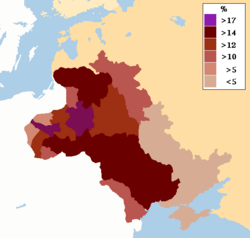
Back يهود أوربا الشرقية Arabic Juden in Mittel- und Osteuropa German Ostjuden French יהדות מזרח אירופה HE Ostjuden Italian Evreii din Europa de Est Romanian
This article needs additional citations for verification. (January 2018) |


The expression Eastern European Jewry has two meanings. Its first meaning refers to the current political spheres of the Eastern European countries and its second meaning refers to the Jewish communities in Russia and Poland. The phrase 'Eastern European Jews' or 'Jews of the East' (from German: Ostjuden) was established during the 20th century in the German Empire and in the western provinces of the Austro-Hungarian Empire, aiming to distinguish the integrating Jews in Central Europe from those Jews who lived in the East. This feature deals with the second meaning of the concept of Eastern European Jewry—the Jewish groups that lived in Poland, Ukraine, Belarus, Latvia, Lithuania, Estonia, Russia, Romania, Hungary and modern-day Moldova in collective settlement (from Hebrew: Kibbutz- קיבוץ), many of whom spoke Yiddish.
At the beginning of the 20th century, over 6 million Jews lived in Eastern Europe. They were organized into large and small communities, living in big cities, such as Warsaw (with a population of about 300,000 Jews), as well as in small towns with populations of only tens or hundreds of Jews.